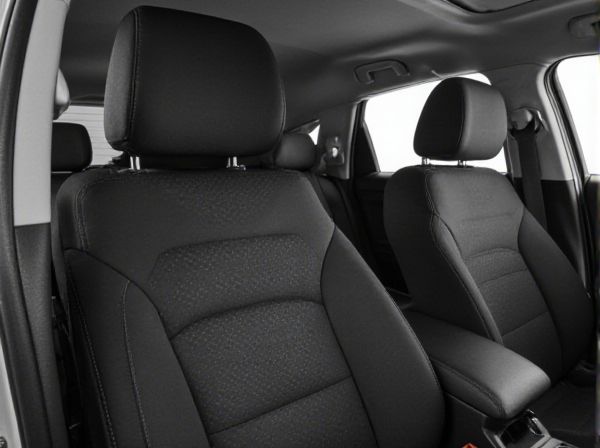
Photo illustration: Integrated Headrest Seat vs Adjustable Headrest Seat
An integrated headrest seat offers a sleek, uniform design with the headrest built directly into the seat, providing consistent support and a streamlined look. Adjustable headrest seats enhance comfort by allowing you to customize the height and angle of the headrest to better suit your posture and preferences. Choosing between these options depends on your need for flexibility versus seamless aesthetics in your vehicle or furniture.
Table of Comparison
| Feature | Integrated Headrest Seat | Adjustable Headrest Seat |
|---|---|---|
| Headrest Type | Fixed, built-in headrest | Movable, height and angle adjustable |
| Comfort | Basic neck support | Enhanced personalized comfort |
| Safety | Standard protection | Improved protection via customizable positioning |
| Design | Seamless, streamlined look | More complex mechanism, varies by model |
| Cost | Generally lower price | Higher price due to adjustability |
| Maintenance | Low, fewer moving parts | Higher, due to adjustable components |
Introduction to Headrest Seat Designs
Integrated headrest seats feature a fixed headrest that is built directly into the seat structure, providing uniform support and enhancing overall seat stability. Adjustable headrest seats offer customizable height and tilt options, allowing users to tailor head support for improved ergonomic comfort. Both designs aim to optimize neck protection and reduce fatigue during extended use, catering to different preferences and applications.
What Are Integrated Headrest Seats?
Integrated headrest seats feature a built-in headrest that is seamlessly molded into the seatback, providing a sleek design with fixed support for the head and neck. These seats enhance vehicle aesthetics and structural integrity but offer limited customization compared to adjustable headrest seats, which allow users to modify the height and angle for personalized comfort and improved safety. Integrated headrest seats are commonly found in sports cars and luxury vehicles where design and rigidity are prioritized over adjustable ergonomics.
Understanding Adjustable Headrest Seats
Adjustable headrest seats offer customizable support by allowing users to modify height and angle for optimal neck and head comfort, reducing strain during prolonged use. Unlike integrated headrest seats with fixed positions, adjustable models enhance ergonomic benefits and accommodate various body types. This flexibility improves posture and safety, especially in automotive and office seating contexts.
Design Differences: Integrated vs Adjustable
Integrated headrest seats feature a fixed, seamless design where the headrest is built directly into the seat structure, offering a sleek and uniform appearance. Adjustable headrest seats provide customizable support with movable headrests that can be tilted, raised, or lowered to enhance comfort and ergonomics for various users. The key design difference lies in the fixed integration of the headrest in one, versus the flexible, user-adjustable mechanism in the other, impacting both aesthetic and functional versatility.
Comfort and Ergonomics Comparison
Integrated headrest seats provide consistent neck support through a fixed design, ensuring proper spinal alignment and reducing discomfort during long drives. Adjustable headrest seats offer customizable positioning to accommodate various body sizes and preferences, enhancing ergonomic support and preventing strain. Both options improve comfort, but adjustable headrests allow for more personalized ergonomic benefits tailored to individual needs.
Safety Considerations and Crash Performance
Integrated headrest seats provide enhanced structural integrity by reducing potential points of failure during collisions, improving occupant protection in side and rear impacts. Adjustable headrest seats offer personalized comfort and proper alignment to reduce the risk of whiplash, but may vary in crash performance depending on the locking mechanism's reliability. Safety assessments often favor integrated designs for their consistent performance in crash tests, while adjustable headrests demand careful use to maintain optimal safety benefits.
Aesthetic and Interior Design Impact
Integrated headrest seats offer a sleek, seamless appearance that enhances the minimalist and modern aesthetic of a vehicle's interior, contributing to a cohesive design flow. Adjustable headrest seats provide flexibility and ergonomic customization but can interrupt the clean lines of the seat structure, potentially disrupting the visual harmony of the cabin. Choosing between the two depends on prioritizing either a refined, uninterrupted interior style or functional adaptability tailored to passenger comfort.
Maintenance and Durability Factors
Integrated headrest seats generally require less maintenance due to their single-piece construction, reducing potential joints or mechanical parts that could wear out over time. Adjustable headrest seats, while offering customized comfort, often involve moving components and mechanisms that may demand regular lubrication and inspection to prevent malfunction. Materials used in integrated designs typically enhance durability by minimizing stress points, whereas adjustable seats might experience wear from repeated adjustments.
Cost Implications for Buyers
Integrated headrest seats typically offer a lower initial cost compared to adjustable headrest seats due to simpler design and fewer moving parts. Adjustable headrest seats, while more expensive upfront, provide enhanced comfort and safety customization that can lead to better long-term value and potential savings on injury-related expenses. Buyers should weigh the upfront price difference against benefits like ergonomic support and vehicle resale value when considering cost implications.
Choosing the Right Headrest Seat for Your Needs
Integrated headrest seats offer a sleek design with fixed support, ideal for users prioritizing style and stability in vehicles or office chairs. Adjustable headrest seats provide customizable comfort and ergonomic benefits, allowing users to modify height and angle to reduce neck strain during long periods of use. Choosing the right headrest seat depends on personal comfort preferences, ergonomic needs, and the specific application, such as driving, office work, or gaming.
 caratoz.com
caratoz.com